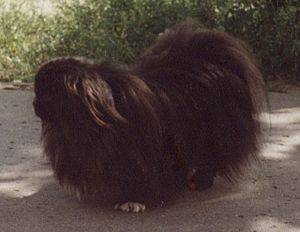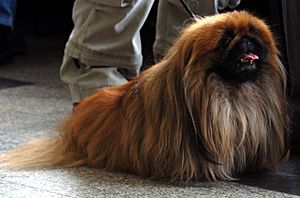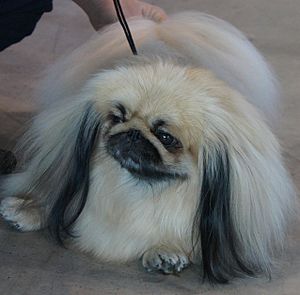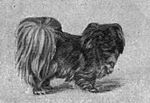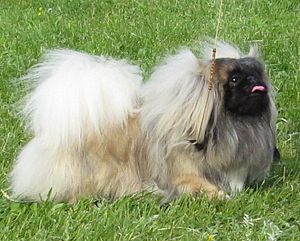Pekingese facts for kids
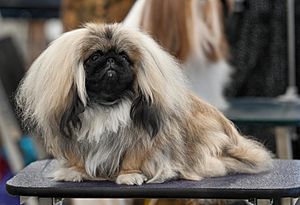
A long-haired Pekingese brushed out and ready for show
|
||||||||
| Common nicknames | Peke | |||||||
|---|---|---|---|---|---|---|---|---|
| Origin | China | |||||||
|
||||||||
| Domestic dog (Canis lupus familiaris) | ||||||||
The Pekingese (also called Pekinese) is a special dog breed that comes from China. These small dogs were very popular with the royal families in China. They were kept as lap dogs and friends. The name "Pekingese" comes from the city of Peking (now called Beijing), where the famous Forbidden City is located. This breed has some unique features and a few health concerns because of its distinct look. The Pekingese has also helped create other popular mixed breeds, like the Peekapoo (a mix with a poodle) and the Peke-a-tese (a mix with a Maltese).
Contents
Pekingese Appearance: What They Look Like
Today, many breeders and dog show judges prefer Pekingese dogs with long, flowing hair. Their most noticeable features are their flat faces and large, expressive eyes. They have a compact body that sits low to the ground. Even though they are small, Pekingese dogs have strong, muscular bodies. Their unique rolling way of walking might have been developed on purpose long ago to keep these royal dogs from wandering too far.
Pekingese Coat: Colors and Care
Pekingese dogs come in many different colors. Most are gold, red, or sable (a mix of colors). You can also find them in cream, black, white, tan, black and tan, and sometimes even 'blue' or slate grey. Dogs with 'blue' coats often have lighter eyes and less pigment. White Pekingese with pink eyes are called albinos and need careful breeding due to possible health issues. Pekingese dogs shed a lot of hair.
Their faces can be solid black (a 'black mask') or the same color as their body. No matter the coat color, their nose, lips, and the skin around their eyes are always black. These dogs need a lot of grooming to keep their long coats neat and healthy.
Pekingese dogs usually weigh between 7 and 14 pounds (about 3 to 6 kg). They stand about 6 to 9 inches (15 to 23 cm) tall at the shoulder. Smaller Pekingese are sometimes called "Sleeve" Pekingese. This name comes from ancient times when Chinese emperors would carry the tiniest dogs in their wide robe sleeves. A Pekingese weighing over 15 pounds (about 6.8 kg) is usually not allowed in dog shows.
When measured from their chest to their rear, Pekingese dogs are a bit longer than they are tall. Their body shape is roughly 3 parts tall to 5 parts long.
Pekingese Health: Keeping Them Healthy
Pekingese dogs typically live for about 11.4 years. One of the main reasons Pekingese, like many other small dog breeds, pass away is from injuries. Other common health issues involve their nervous system and heart, such as heart failure. If caught early and treated with medicine, a Pekingese with heart problems can live for many more years. A heart murmur can be a sign of a problem and should be checked by a dog heart specialist. Often, these heart issues don't show up until the dog is 6 years old or older, making it hard to check for them in puppies.
Because of their desired flat face shape, Pekingese dogs can have a skull problem called brachycephaly. This means their main problems are often eye issues and breathing difficulties. These problems happen because of their small skulls and flattened faces. They can also get skin allergies and hotspots. A very common problem is eye ulcers, which can appear suddenly. Pekingese can also get dry eye (keratoconjunctivitis sicca) and progressive retinal atrophy, which can lead to glaucoma (pressure on the eye).
Pekingese dogs should not live outside. Their flat faces and noses make it hard for them to breathe, especially in very hot or cold weather. This means they struggle to control their body temperature. Their long backs, compared to their short legs, make them prone to back injuries. When you pick them up, always support their back by placing one hand under their chest and the other under their belly. Their short legs can also make it hard for some Pekingese to go up or down stairs, especially as they get older.
To help with their breathing problems, the Kennel Club in the UK changed the breed standard in 2008. They removed the rule that the "profile [should be] flat with nose well up between eyes" and added that the "muzzle must be evident." This change was made after public concern about flat-faced breeds. The standards for other flat-faced breeds like the Pug and English Bulldog were also changed.
Pekingese Care: Looking After Your Dog
Keeping a Pekingese's coat healthy means brushing it every day. They also need to visit a professional groomer every 8 to 12 weeks. If your Pekingese is a family pet and not a show dog, you can keep their hair in a shorter "puppy cut" which needs less care. It's also important to gently clean their eyes daily and wipe the creases on their face to prevent sores. You also need to keep the fur around their rear end clean and well-groomed to avoid messes.
Because they have so much fur, it's important to keep Pekingese dogs cool. They can easily get heatstroke if they are in high temperatures for too long.
Pekingese dogs don't need a lot of exercise. Because of their very short snouts, they often have breathing problems (called Brachycephalic obstructed airway syndrome). This means they can only handle about 30 minutes of exercise each day. It's important to watch their breathing while they exercise, especially in warm weather. If your Pekingese starts wheezing, stop exercising right away. After running, they should rest in a cool place until their breathing returns to normal. Always make sure they have plenty of water before, during, and after exercise to prevent them from getting too hot or dehydrated.
Pekingese History: From Ancient China to Today

The Pekingese breed started in China. For a long time, only members of the Chinese Imperial Palace in the Forbidden City were allowed to own them.
In 1860, during the Second Opium War, British and French soldiers entered the Old Summer Palace in Beijing. The emperor had already left, but an elderly aunt of the emperor stayed behind. When the soldiers arrived, they found her dead with five Pekingese dogs still alive. The soldiers took these dogs before the Summer Palace was burned down.
Lord John Hay took two of these dogs, named Schloff and Hytien, and gave them to his sister, the Duchess of Wellington. Sir George Fitzroy took another pair and gave them to his cousins. A soldier named Lieutenant Dunne gave the fifth Pekingese to Queen Victoria, who named it Looty.
Later, the Empress Dowager Cixi gave Pekingese dogs as gifts to several Americans. These included John Pierpont Morgan and Alice Lee Roosevelt Longworth, who was the daughter of President Theodore Roosevelt. Alice named her dog Manchu.
The first Pekingese in Ireland was brought by Dr. Heuston. He had set up smallpox vaccination clinics in China. The Chinese minister, Li Hongzhang, was so grateful that he gave Dr. Heuston a pair of Pekingese dogs named Chang and Lady Li. Dr. Heuston then started the Greystones kennel.
Around the early 1900s, Pekingese dogs became very popular in Western countries. Famous people like Alexandra of Denmark (the wife of King Edward VII) and Elsie de Wolfe, a well-known American interior decorator, owned them. Later, the author Rumer Godden owned them and wrote that Pekingese were "not dogs but something more." The writer Auberon Waugh also owned them.
In recent years, their popularity has gone down a bit, with breeds like the Shih Tzu becoming more popular. However, in 2021, a Pekingese named Wasabi won the famous Westminster Kennel Club Dog Show.
Sleeve Pekingese: Tiny Companions
The "Sleeve Pekingese" is a miniature version of the regular-sized Pekingese. The name comes from the old custom of carrying these tiny dogs in the large sleeves of the robes worn by people in the Chinese Imperial Household. While this tradition might have started in Italy, the Chinese Imperial family adopted it. This led to people trying to breed dogs as small as possible. Some old practices to stunt their growth included giving puppies rice wine or holding newborns tightly. However, the Dowager Empress Cixi reportedly stopped these practices.
In the mid-1900s, a "Sleeve" Pekingese in Britain weighed no more than 6-7 pounds (about 2.7-3.2 kg), and some were as small as 3-4 pounds (about 1.4-1.8 kg). These tiny dogs could appear in litters from full-sized Pekingese. They were often shown in special classes at dog shows for dogs weighing less than 7 pounds. In 1946, cream and white were very popular colors for Sleeve Pekingese, with white being especially admired.
Pekingese Legends: How They Came to Be
There are two main stories about how the Pekingese breed began.
The first and most common story is about The Lion and the Marmoset:
- A mighty lion fell in love with a tiny marmoset.
- The lion was too big, so he went to the Buddha and shared his sadness.
- The Buddha allowed the lion to shrink down to the size of the marmoset.
- And from their love, the Pekingese was created!
The second, less common, story is called The Butterfly Lions:
- A powerful lion fell in love with a beautiful butterfly.
- The lion and the butterfly knew their size difference was too great.
- Together, they went to see the Buddha.
- The Buddha allowed them to meet in the middle, becoming a new size. From this, the Pekingese came to be.
See also
 In Spanish: Pekinés (raza de perro) para niños
In Spanish: Pekinés (raza de perro) para niños


